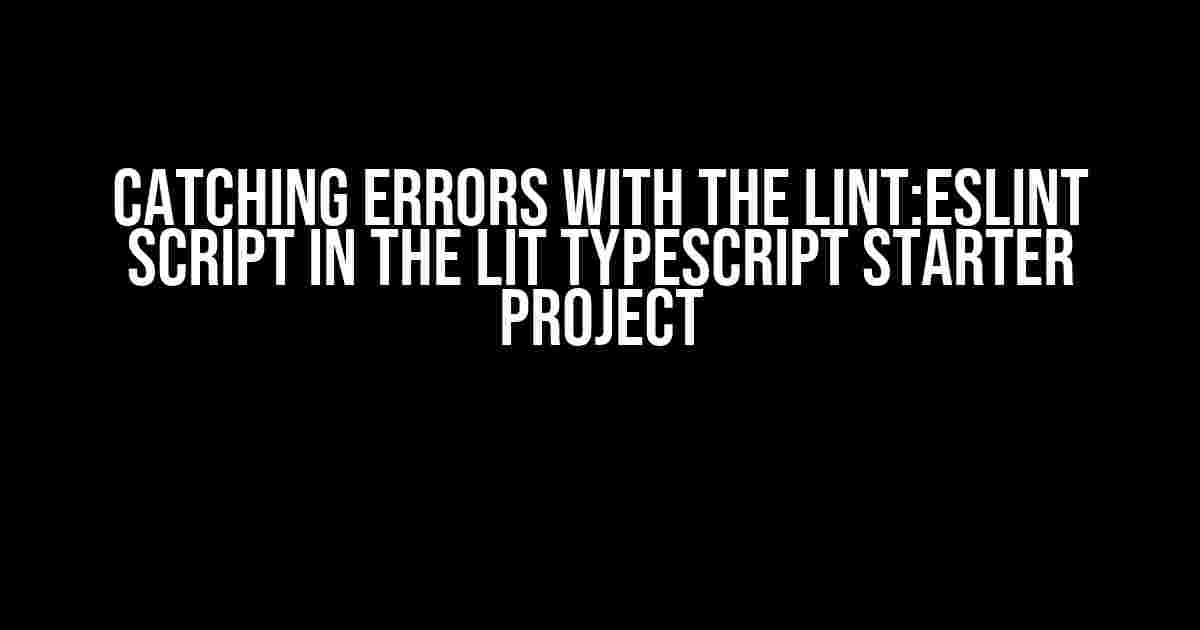Welcome to the world of error-free coding with Lit and TypeScript! As a developer, you know how frustrating it can be to spend hours debugging your code, only to find that a single typo or misplaced character is causing the issue. That’s where the lint:eslint script comes in – a game-changing tool that helps you catch errors and warnings in your Lit TypeScript project. In this article, we’ll dive into the world of error-catching and explore how to get the most out of the lint:eslint script in your Lit TypeScript starter project.
What is the lint:eslint Script?
The lint:eslint script is a built-in tool in the Lit TypeScript starter project that helps you identify and fix errors and warnings in your code. It’s based on the popular ESLint library, which provides a set of rules and guidelines for writing clean, maintainable, and error-free code.
When you run the lint:eslint script, it analyzes your code and checks for a wide range of issues, including:
- Syntax errors
- Unused variables and imports
- Duplicate keys in objects
- Unused functions and variables
- Inconsistent spacing and formatting
- Deprecated syntax and APIs
Setting Up the Lint:eslint Script
To start using the lint:eslint script, you’ll need to have the Lit TypeScript starter project set up on your machine. If you haven’t done so already, create a new project by running the following command in your terminal:
npx lit init my-lit-projectThis will create a new Lit TypeScript project called “my-lit-project” with the necessary dependencies and configuration files.
Next, navigate to the root of your project directory and run the following command to install ESLint:
npm install eslint --save-devThis will install ESLint as a development dependency in your project.
Running the Lint:eslint Script
Now that you have ESLint installed, you can run the lint:eslint script by executing the following command in your terminal:
npx lit lint:eslintThis will analyze your code and display any errors or warnings it finds. If everything is okay, you’ll see a message indicating that there are no issues.
But what if you do encounter errors or warnings? Don’t worry, we’ve got you covered! In the next section, we’ll explore how to fix common issues caught by the lint:eslint script.
Frequently Encountered Errors and Warnings
In this section, we’ll take a closer look at some common errors and warnings that the lint:eslint script might catch, along with tips on how to fix them.
Unused Variables and Imports
One of the most common issues caught by the lint:eslint script is unused variables and imports. This can happen when you declare a variable or import a module but never use it in your code.
Here’s an example of an error message you might see:
'myVariable' is assigned a value but never used. (no-unused-vars)To fix this issue, simply remove the unused variable or import. For example:
import { foo } from 'my-module'; // Remove this line
const myVariable = 'hello'; // Remove this lineDuplicate Keys in Objects
Another common issue is duplicate keys in objects. This can happen when you accidentally define the same key multiple times in an object.
Here’s an example of an error message you might see:
Duplicate key 'myKey' in object. (no-dupe-keys)To fix this issue, remove the duplicate key from your object. For example:
const myObject = {
myKey: 'hello',
myKey: 'world' // Remove this line
};Inconsistent Spacing and Formatting
The lint:eslint script can also catch issues with inconsistent spacing and formatting in your code. This can make your code harder to read and maintain.
Here’s an example of an error message you might see:
Expected X spaces between 'function' and '{' but found Y. (constructor-super-spacing)To fix this issue, make sure to maintain consistent spacing and formatting throughout your code. For example:
function myFunction() {
// Correct spacing and formatting
}Customizing the Lint:eslint Script
By default, the lint:eslint script uses a set of predefined rules and configurations to analyze your code. However, you can customize the script to fit your specific needs and preferences.
One way to customize the lint:eslint script is by creating an .eslintrc file in the root of your project directory. This file allows you to define custom rules, disable or enable specific rules, and adjust the severity of errors and warnings.
Here’s an example of an .eslintrc file that disables the “no-console” rule and sets the severity of errors to “error”:
{
"root": true,
"env": {
"node": true
},
"rules": {
"no-console": "off"
},
"parserOptions": {
"ecmaVersion": 2020,
"sourceType": "module",
"ecmaFeatures": {
"jsx": true
}
},
"severity": "error"
}By customizing the lint:eslint script, you can tailor it to your specific needs and preferences, ensuring that it catches the errors and warnings that matter most to you.
Conclusion
In this article, we’ve explored the powerful features and benefits of the lint:eslint script in the Lit TypeScript starter project. By running this script regularly, you can catch errors and warnings early on, saving yourself hours of debugging time and frustration.
Whether you’re a seasoned developer or just starting out, the lint:eslint script is an invaluable tool that can help you write cleaner, more maintainable, and error-free code. So why wait? Start using the lint:eslint script today and take your coding skills to the next level!
| Error/Warning | Description | Fix |
|---|---|---|
| Unused variables and imports | Declare a variable or import a module but never use it | Remove the unused variable or import |
| Duplicate keys in objects | Accidentally define the same key multiple times in an object | Remove the duplicate key from your object |
| Inconsistent spacing and formatting | Make code harder to read and maintain | Maintain consistent spacing and formatting |
By following the guidelines and best practices outlined in this article, you’ll be well on your way to writing error-free code with the lint:eslint script in your Lit TypeScript starter project. Happy coding!
Frequently Asked Questions
Get ready to debug like a pro! Here are some common questions and answers about catching errors with the lint:eslint script in the lit TypeScript starter project:
What is the purpose of the lint:eslint script in the lit TypeScript starter project?
The lint:eslint script is a tool that helps you catch errors and enforce code quality in your lit TypeScript project. It uses ESLint to analyze your code and identify potential issues, such as syntax errors, styling inconsistencies, and security vulnerabilities. By running the script, you can ensure that your code meets the project’s coding standards and best practices.
How do I run the lint:eslint script in the lit TypeScript starter project?
To run the lint:eslint script, navigate to the root directory of your project and execute the command `npm run lint:eslint` or `yarn lint:eslint` in your terminal. This will trigger the ESLint analysis and display a report of any errors or warnings found in your code.
What types of errors can the lint:eslint script detect in my lit TypeScript code?
The lint:eslint script can detect a wide range of errors and issues in your lit TypeScript code, including syntax errors, type errors, unused variables, inconsistent naming conventions, and security vulnerabilities. It can also enforce coding standards, such as maximum line length, indentation, and spacing.
Can I customize the lint:eslint script to fit my project’s specific needs?
Yes, you can customize the lint:eslint script to fit your project’s specific needs. You can modify the ESLint configuration file (.eslintrc.json) to define custom rules, disable or enable specific rules, and adjust the script’s behavior to suit your project’s requirements.
How often should I run the lint:eslint script in my lit TypeScript project?
It’s a good practice to run the lint:eslint script regularly during development, ideally before committing changes to your code repository. You can also set up your project to run the script automatically on every code change or as part of your Continuous Integration (CI) pipeline.





